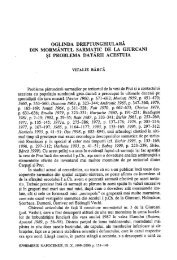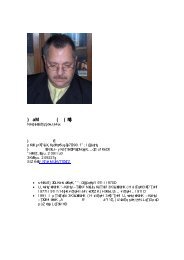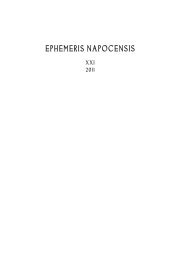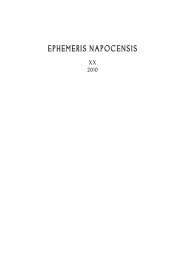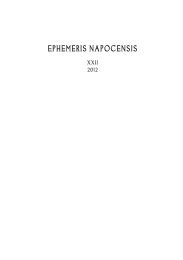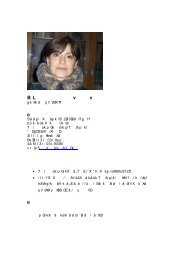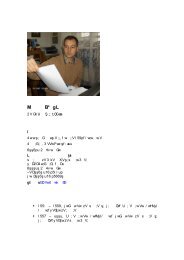EPHEMERIS NAPOCENSIS - Institutul de Arheologie şi Istoria Artei
EPHEMERIS NAPOCENSIS - Institutul de Arheologie şi Istoria Artei
EPHEMERIS NAPOCENSIS - Institutul de Arheologie şi Istoria Artei
You also want an ePaper? Increase the reach of your titles
YUMPU automatically turns print PDFs into web optimized ePapers that Google loves.
“SPA” VIGNETTES IN TABULA PEUTINGERIANA. TRAVELLING<br />
AD AQUAS: THERMAL WATER RESOURCES IN ROMAN DACIA 1<br />
Florin Fodorean 2<br />
Abstract: Tabula Peutingeriana is the most famous “map” of the Roman world. It represents the main<br />
Roman roads, the name of the cities with vignettes, representations of temples, and also edifices type “spa”.<br />
Our paper will start with some consi<strong>de</strong>rations regarding the thermal water resources in the Roman world.<br />
Then, we will present the main characteristics of the settlements represented with “spa” vignettes. Among<br />
them, three are in Roman Dacia. The most famous is the settlement from Germisara (today Geoagiu-Băi,<br />
Hunedoara County). This settlement was constantly visited in the Roman times, mainly because of the<br />
quality of the thermal waters, and due to its position, in the centre of the province. Marcus Statius Priscus,<br />
governor of Dacia Superior in 157 and 158 AD, is mentioned here in two votive monuments for the<br />
gods and the protectors of the thermal water. The next governor of Dacia Superior (in 161 AD), Publius<br />
Furius Saturninus, is also mentioned at Germisara in two votive inscriptions. This important character<br />
is mentioned in Dacia in 7 inscriptions. The thermal place was also visited by <strong>de</strong>curiones and quaestores<br />
from Sarmizegetusa and Apulum, augustales from Sarmizegetusa, soldiers from the auxiliary troops, a<br />
representative of a collegium Galatarum and another of a collegium aurariarum. The other two settlements<br />
were Ad Aquas (Călan) and Ad Mediam (Băile Herculane). So, we will explore the Roman Dacia and<br />
the Empire trying to un<strong>de</strong>rstand, perceive and <strong>de</strong>scribe, archaeologically and epigraphically, the resources<br />
of these thermal settlements.<br />
Keywords: spa vignettes, tourism, Roman Dacia, Ad Aquas, Germisara, Ad Mediam<br />
1. Into the Roman world. Natural resources: thermal waters<br />
It is hard today for us to un<strong>de</strong>rstand, in an era in which we make online reservations,<br />
fly by plain, ‘see’ using Google earth places we have never been, or schedule our time carefully,<br />
how other civilizations <strong>de</strong>veloped their perception concerning free time and the possibility to<br />
benefit of natural resources. But we would be surprised to see that, besi<strong>de</strong>s our technological<br />
means, Roman world was conscious about these things, too. The passion of the Romans for<br />
waters is famous 3 . It was transformed in exquisite, outstanding works of art. These were the<br />
aqueducts. Hundreds were built all over the Roman Empire. They were extremely sophisticated<br />
1 This article was written during my research stay in Germany, at the University of Erfurt. I received the<br />
support of the Fritz Thyssen Stiftung, which provi<strong>de</strong>d me a post-doctoral scholarship in 2011, therefore I express<br />
my gratitu<strong>de</strong> for Thyssen Foundation. I also want to thank prof. dr. Kai Bro<strong>de</strong>rsen, my supervisor in Germany, for<br />
all his constant help and support during my stay in Erfurt.<br />
2 Assistant professor, Ph. D, Babeş-Bolyai University Cluj-Napoca, Faculty of History and Philosophy, Department<br />
of Ancient History and Archaeology, Avram Iancu street, no. 11, Cluj-Napoca; e-mail: fodorean_f@yahoo.com.<br />
3 BLACKMAN/TREVOR 2001; DEMAN 2005; LANDELS 2000; TREVOR 2002.<br />
Ephemeris Napocensis, XXII, 2012, p. 211–221



